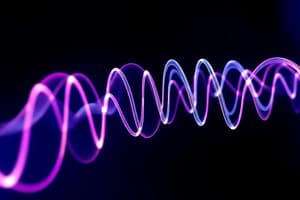Podcast
Questions and Answers
What does the equation $
rac{d ext{ΦE}}{dt} = i$ represent in relation to the changing charge on capacitor plates?
What does the equation $ rac{d ext{ΦE}}{dt} = i$ represent in relation to the changing charge on capacitor plates?
- The resistance in the capacitor circuit
- The electric field strength across the capacitor
- The total electric charge stored in the capacitor
- The rate of change of electric flux through a surface (correct)
In the context of generalized Ampere’s law, what additional term is accounted for when the charge $Q$ on the capacitor plates changes with time?
In the context of generalized Ampere’s law, what additional term is accounted for when the charge $Q$ on the capacitor plates changes with time?
- The voltage across the capacitor plates
- The mechanical energy change in the system
- The total magnetic field generated by the capacitor
- The displacement current, which is proportional to the rate of change of electric displacement field (correct)
How does the presence of a current $i$ due to charge changes affect the magnetic field $B$ according to the generalised Ampere's law?
How does the presence of a current $i$ due to charge changes affect the magnetic field $B$ according to the generalised Ampere's law?
- It creates a zero magnetic field outside the plates
- It only increases the magnetic field intensity outside the capacitor
- It results in a uniform magnetic field in all regions of space
- It ensures that the magnetic field calculated is the same regardless of the surface used (correct)
What does the term $
rac{dQ}{dt}$ represent in the context of capacitors?
What does the term $ rac{dQ}{dt}$ represent in the context of capacitors?
According to Gauss's Law, what can be concluded if the total charge $Q$ on the capacitor plates changes with time?
According to Gauss's Law, what can be concluded if the total charge $Q$ on the capacitor plates changes with time?
What implication does the rate of change of electric flux have on the conduction current?
What implication does the rate of change of electric flux have on the conduction current?
In the scenario where a time-dependent current $i(t)$ flows through a capacitor, what can be inferred about the behavior of magnetic fields around the capacitor?
In the scenario where a time-dependent current $i(t)$ flows through a capacitor, what can be inferred about the behavior of magnetic fields around the capacitor?
What is notably different in the electric discharge from a capacitor compared to the steady-state current in a circuit?
What is notably different in the electric discharge from a capacitor compared to the steady-state current in a circuit?
What fundamental principle does Faraday’s law of electromagnetic induction illustrate?
What fundamental principle does Faraday’s law of electromagnetic induction illustrate?
Which statement best describes the relationship between electric and magnetic fields according to the Ampere-Maxwell law?
Which statement best describes the relationship between electric and magnetic fields according to the Ampere-Maxwell law?
Which of the following correctly states Gauss's Law for magnetism?
Which of the following correctly states Gauss's Law for magnetism?
What does the symmetry observed in electromagnetic induction imply about electromagnetic waves?
What does the symmetry observed in electromagnetic induction imply about electromagnetic waves?
In a capacitor charging circuit, how is the time constant defined?
In a capacitor charging circuit, how is the time constant defined?
After how much time will a capacitor connected to a circuit achieve approximately 63% of its maximum charge?
After how much time will a capacitor connected to a circuit achieve approximately 63% of its maximum charge?
What is the consequence of the displacement current according to the Ampere-Maxwell Law?
What is the consequence of the displacement current according to the Ampere-Maxwell Law?
What can be inferred about magnetic monopoles based on the content provided?
What can be inferred about magnetic monopoles based on the content provided?
What is the role of the displacement current in a capacitor?
What is the role of the displacement current in a capacitor?
Which statement correctly describes the relationship between conduction current and displacement current inside a capacitor?
Which statement correctly describes the relationship between conduction current and displacement current inside a capacitor?
What additional aspect does Maxwell's modification of Ampere's Law introduce?
What additional aspect does Maxwell's modification of Ampere's Law introduce?
In the context of electric and magnetic fields in a capacitor, what occurs outside the capacitor plates?
In the context of electric and magnetic fields in a capacitor, what occurs outside the capacitor plates?
According to the generalized Ampere’s circuital law, what constitutes the total current passing through a surface?
According to the generalized Ampere’s circuital law, what constitutes the total current passing through a surface?
What does the variable ε0 represent in the equation for displacement current?
What does the variable ε0 represent in the equation for displacement current?
Which of the following statements is true regarding magnetic and electric fields within the capacitor?
Which of the following statements is true regarding magnetic and electric fields within the capacitor?
What is the mathematical representation of the displacement current established by Maxwell?
What is the mathematical representation of the displacement current established by Maxwell?
Flashcards
Faraday's Law of Electromagnetic Induction
Faraday's Law of Electromagnetic Induction
A changing magnetic field creates an electric field.
Ampere-Maxwell Law
Ampere-Maxwell Law
A changing electric field creates a magnetic field.
Electromagnetic Waves
Electromagnetic Waves
Self-sustaining waves of electric and magnetic fields.
Magnetic Monopoles
Magnetic Monopoles
Signup and view all the flashcards
Displacement Current
Displacement Current
Signup and view all the flashcards
Gauss's Law for Electricity
Gauss's Law for Electricity
Signup and view all the flashcards
Gauss's Law for Magnetism
Gauss's Law for Magnetism
Signup and view all the flashcards
Time-Dependent Electric and Magnetic Fields
Time-Dependent Electric and Magnetic Fields
Signup and view all the flashcards
Gauss's Law for Electric Flux
Gauss's Law for Electric Flux
Signup and view all the flashcards
Electric Flux (ΦE)
Electric Flux (ΦE)
Signup and view all the flashcards
Conduction Current (i)
Conduction Current (i)
Signup and view all the flashcards
Rate of Change of Electric Flux
Rate of Change of Electric Flux
Signup and view all the flashcards
Generalized Ampere's Law
Generalized Ampere's Law
Signup and view all the flashcards
Time-Varying Electric Field
Time-Varying Electric Field
Signup and view all the flashcards
Capacitor
Capacitor
Signup and view all the flashcards
Relationship Between Changing Flux and Current
Relationship Between Changing Flux and Current
Signup and view all the flashcards
Maxwell's Displacement Current
Maxwell's Displacement Current
Signup and view all the flashcards
Total Current in Ampere's Law
Total Current in Ampere's Law
Signup and view all the flashcards
Displacement Current (id)
Displacement Current (id)
Signup and view all the flashcards
Generalized Ampere's Circuital Law
Generalized Ampere's Circuital Law
Signup and view all the flashcards
Inside the Capacitor
Inside the Capacitor
Signup and view all the flashcards
Outside the Capacitor
Outside the Capacitor
Signup and view all the flashcards
Maxwell's Contribution
Maxwell's Contribution
Signup and view all the flashcards
Study Notes
Electromagnetic Waves
- Maxwell's equations describe electric and magnetic fields and their sources, including charges and current densities.
- Changes in either electric or magnetic fields create the other.
- Accelerated charges produce electromagnetic waves.
- Electromagnetic waves are self-sustaining oscillations of electric and magnetic fields in free space.
- Electromagnetic waves do not require a medium to propagate.
- The speed of electromagnetic waves in a vacuum is constant (approximately 3 × 10⁸ m/s).
- Electromagnetic waves have both electric and magnetic field components that are perpendicular to each other and the direction of propagation.
- The magnitude of the electric and magnetic fields are related via B = (E₀/c).
- The frequency of an electromagnetic wave equals the frequency of oscillation of the charge producing it.
- Electromagnetic waves carry energy and momentum.
- The total momentum delivered to a surface struck by electromagnetic waves is given by p = U/c, where U is the total energy transferred to the surface in time t.
Maxwell's Equations
- E⋅dA = Q/ε₀ (Gauss's Law for Electricity)
- B⋅dA = 0 (Gauss's Law for Magnetism)
- E⋅dl = -dΦB/dt (Faraday's Law)
- B⋅dl = μ₀i + μ₀ε₀dΦE/dt (Ampere-Maxwell Law)
Electromagnetic Spectrum
- The electromagnetic spectrum encompasses a range of electromagnetic waves, organized by frequency and wavelength.
- Various regions of the EM spectrum have different names (gamma rays, X-rays, ultraviolet, visible, infrared, microwaves, and radio waves).
- The regions in the spectrum are not sharply divided; there are overlaps.
- The wavelength range of each type of wave varies greatly.
- Sources and detection methods for each type of wave vary.
Studying That Suits You
Use AI to generate personalized quizzes and flashcards to suit your learning preferences.




